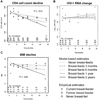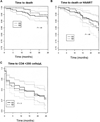HIV-1 disease progression in breast-feeding and formula-feeding mothers: a prospective 2-year comparison of T cell subsets, HIV-1 RNA levels, and mortality
- PMID: 17191167
- PMCID: PMC3394541
- DOI: 10.1086/510245
HIV-1 disease progression in breast-feeding and formula-feeding mothers: a prospective 2-year comparison of T cell subsets, HIV-1 RNA levels, and mortality
Abstract
Background: There is conflicting evidence regarding the effects of breast-feeding on maternal mortality from human immunodeficiency virus type 1 (HIV-1) infection, and little is known about the effects of breast-feeding on markers of HIV-1 disease progression.
Methods: HIV-1-seropositive women were enrolled during pregnancy and received short-course zidovudine. HIV-1 RNA levels and CD4 cell counts were determined at baseline and at months 1, 3, 6, 12, 18, and 24 postpartum and were compared between breast-feeding and formula-feeding mothers.
Results: Of 296 women, 98 formula fed and 198 breast-fed. At baseline, formula-feeding women had a higher education level and prevalence of HIV-1-related illness than did breast-feeding women; however, the groups did not differ with respect to CD4 cell counts and HIV-1 RNA levels. Between months 1 and 24 postpartum, CD4 cell counts decreased 3.9 cells/ microL/month (P<.001), HIV-1 RNA levels increased 0.005 log(10) copies/mL/month (P=.03), and body mass index (BMI) decreased 0.03 kg/m(2)/month (P<.001). The rate of CD4 cell count decline was higher in breast-feeding mothers (7.2 cells/ microL/month) than in mothers who never breast-fed (4.0 cells/ microL/month) (P=.01). BMI decreased more rapidly in breast-feeding women (P=.04), whereas HIV-1 RNA levels and mortality did not differ significantly between breast-feeding and formula-feeding women.
Conclusions: Breast-feeding was associated with significant decreases in CD4 cell counts and BMI. HIV-1 RNA levels and mortality were not increased, suggesting a limited adverse impact of breast-feeding in mothers receiving extended care for HIV-1 infection.
Conflict of interest statement
Potential conflicts of interest: none reported.
Figures




Comment in
-
Balancing maternal and infant benefits and the consequences of breast-feeding in the developing world during the era of HIV infection.J Infect Dis. 2007 Jan 15;195(2):165-7. doi: 10.1086/510255. Epub 2006 Dec 13. J Infect Dis. 2007. PMID: 17191159 No abstract available.
-
Re: HIV-1 disease progression in breast-feeding and formula-feeding mothers: a prospective 2-year comparison of T cell subsets, HIV-1 RNA levels, and mortality.J Infect Dis. 2007 Jun 1;195(11):1728-9; author reply 1729-30. doi: 10.1086/517530. J Infect Dis. 2007. PMID: 17471447 Free PMC article. No abstract available.
References
-
- Coutsoudis A, Coovadia H, Pillay K, Kuhn L. Are HIV-infected women who breastfeed at increased risk of mortality? AIDS. 2001;15:653–655. - PubMed
-
- Sedgh G, Spiegelman D, Larsen U, Msamanga G, Fawzi WW. Breastfeeding and maternal HIV-1 disease progression and mortality. AIDS. 2004;18:1043–1049. - PubMed
-
- Breastfeeding and HIV International Transmission Study Group. Mortality among HIV-1 infected women according to children’s feeding modality. J Acquir Immune Defic Syndr. 2005;39:430–438. - PubMed
Publication types
MeSH terms
Substances
Grants and funding
LinkOut - more resources
Full Text Sources
Medical
Research Materials

